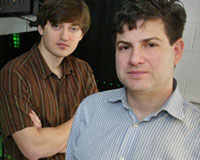 |
Jacksonville, FL (SPX) Apr 13, 2010 Boeing representatives joined the U.S. Air Force and Florida Air National Guard (ANG) in Jacksonville to roll out the first operational ANG F-15C equipped with an Active Electronically Scanned Array (AESA) radar. Boeing is under contract to upgrade 14 ANG and 10 Air Force F-15C/D aircraft with AESA. The Raytheon APG-63(V)3 AESA radar being installed on the F-15s combines the operationally proven APG-63(V)2 software with the advanced APG-79 Transmit/Receive hardware found on the F/A-18E/F Super Hornet. It is a reliable and affordable high-performance AESA for the F-15 air-to-air variant. The AESA radar antenna is 50 times more reliable than the mechanically scanned antenna it replaces. "The (V)3 AESA radar will greatly improve F-15 pilots' situational awareness, beyond-visual-range targeting, and weapon accuracy," said Jim Means, director of Proprietary Programs for Boeing Global Strike Systems. "The new radar also enhances the capability to find and track small targets at low altitude - a capability the ANG will employ in its Homeland Defense Air Sovereignty role. The addition of a built-in test function on the AESA antenna makes the (V)3 easier to maintain." The APG-63(V)3 radar is the latest in a series of planned upgrades that will ensure the F-15C's combat-proven air supremacy well into the 21st century. These include a fighter-to-fighter data link, GPS navigation and the Joint Helmet Mounted Cueing System, enabling the fighter to conduct network centric operations while employing the latest air-to-air weapons. Boeing Global Services and Support provides sustainment services for the Air Force F-15 fleet, including spares and retrofit programs, field service teams and a full range of training systems and services.
Share This Article With Planet Earth
Related Links - Space Technology News - Applications and Research
 Engineers Turn Noise Into Vision
Engineers Turn Noise Into VisionPrinceton NJ (SPX) Apr 05, 2010 A new technique for revealing images of hidden objects may one day allow pilots to peer through fog and doctors to see more precisely into the human body without surgery. Developed by Princeton engineers, the method relies on the surprising ability to clarify an image using rays of light that would typically make the image unrecognizable, such as those scattered by clouds, human tissue or murky ... read more |
|
| The content herein, unless otherwise known to be public domain, are Copyright 1995-2010 - SpaceDaily. AFP and UPI Wire Stories are copyright Agence France-Presse and United Press International. ESA Portal Reports are copyright European Space Agency. All NASA sourced material is public domain. Additional copyrights may apply in whole or part to other bona fide parties. Advertising does not imply endorsement,agreement or approval of any opinions, statements or information provided by SpaceDaily on any Web page published or hosted by SpaceDaily. Privacy Statement |